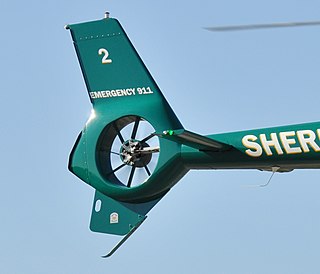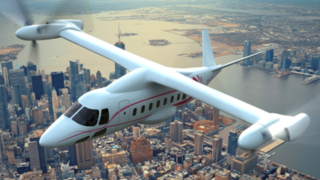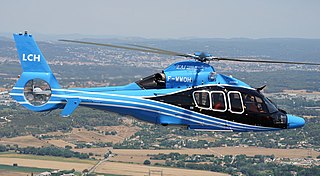Airbus Helicopters SAS is the helicopter manufacturing division of Airbus. It is the largest in the industry in terms of revenues and turbine helicopter deliveries. Its head office is located at Marseille Provence Airport in Marignane, France, near Marseille. The main facilities of Airbus Helicopters are at its headquarters in Marignane, France, and in Donauwörth, Germany, with additional production plants in Canada, Brazil (Helibras), Australia, Spain, Romania, the United Kingdom and the United States. The company was renamed from Eurocopter to Airbus Helicopters on 2 January 2014. In 2018, Airbus delivered 356 helicopters, a 54% share of the civil or parapublic market over five seats.

The EurocopterEC120 Colibri ("hummingbird") is a five-seat, single-engine, light utility helicopter. Jointly designed and developed by Eurocopter, China National Aero-Technology Import & Export Corporation (CATIC), Harbin Aviation Industries (Group) Ltd (HAIG) and Singapore Technologies Aerospace Ltd (STAero) at Eurocopter France's Marignane facility, the EC120B was assembled by Eurocopter in France and Australia.

The Eurocopter EC135 is a twin-engine civil light utility helicopter produced by Airbus Helicopters. It is capable of flight under instrument flight rules (IFR) and is outfitted with a digital automatic flight control system (AFCS). First flying on 15 February 1994, it entered service in 1996 and 1,400 have been delivered up to September 2020 to 300 operators in 60 countries, accumulating over 5 million flight hours. It is mainly used for helicopter emergency medical services, corporate transport, law enforcement, offshore wind support, and military flight training. Half of them are in Europe and a quarter in North America. The H135M, certified under the name Eurocopter EC635, is a military variant.

A Fenestron is an enclosed helicopter tail rotor that operates like a ducted fan. The term Fenestron is a trademark of multinational helicopter manufacturing consortium Airbus Helicopters. The word itself comes from the Occitan term for a small window, and is ultimately derived from the Latin word fenestra for window.

The Airbus Helicopters H145 is a twin-engine light utility helicopter developed and manufactured by Airbus Helicopters. Originally designated as the BK 117, the H145 is based upon the MBB/Kawasaki BK 117 C1, which became a part of the combined Eurocopter line-up in 1992 with the merger of Messerschmitt-Bölkow-Blohm's helicopter division of Daimler-Benz into Eurocopter. The helicopter was earlier named EC145; an updated version, EC145 T2, was renamed H145 in 2015.

The EurocopterEC130 is a single engine light utility helicopter developed from the earlier Eurocopter AS350 Écureuil, one of the primary changes from which was the adoption of a Fenestron anti-torque device in place of a conventional tail rotor. It was launched and produced by the Eurocopter Group, which would later be rebranded as Airbus Helicopters.

The EurocopterAS355 Écureuil 2 is a twin-engine light utility helicopter developed and originally manufactured by Aérospatiale in France

The Eurocopter EC155 is a long-range medium-lift passenger transport helicopter developed by Eurocopter from its Dauphin family for civil aviation use. It is a twin-engined aircraft and can carry up to 13 passengers along with 1 or 2 crew, depending on customer configuration. The helicopter is marketed for passenger transport, offshore support, VIP corporate transport and casualty transport duties. In 2015, the EC155 was formally renamed to the H155, in line with Eurocopter's corporate rebranding as Airbus Helicopters.

The Eurocopter EC635 is a multi-purpose light helicopter developed by Eurocopter as a military version of the Eurocopter EC135. It is a twin-engined aircraft and can carry up to 8 people, including the pilot, and a range of military equipment or armaments. The helicopter is marketed for troop transport, medical evacuation, cargo transport, reconnaissance and surveillance and armed combat support missions.

The Airbus Helicopters H175 is a 7-ton class super-medium utility helicopter produced by Airbus Helicopters. In China, the H175 is produced by the Aviation Industry Corporation of China (AVIC) as the Avicopter AC352. Originally launched as the Eurocopter EC175 and the Harbin Z-15, it has been referred to as being a 'super-medium' helicopter.

The Guimbal Cabri G2 is a two-seat light helicopter produced by Hélicoptères Guimbal, and powered by a reciprocating engine. Designed by Bruno Guimbal, a former Eurocopter engineer, it had its origins in the 1980s, and the first demonstrator flew in 1992. Following the granting of regulatory approval, the Cabri entered commercial service in 2008. In addition to its use within the general aviation sector and as a training rotorcraft, the Cabri G2 has also been used as the basis for unmanned aerial vehicles (UAVs).

The slowed rotor principle is used in the design of some helicopters. On a conventional helicopter the rotational speed of the rotor is constant; reducing it at lower flight speeds can reduce fuel consumption and enable the aircraft to fly more economically. In the compound helicopter and related aircraft configurations such as the gyrodyne and winged autogyro, reducing the rotational speed of the rotor and offloading part of its lift to a fixed wing reduces drag, enabling the aircraft to fly faster.

The Eurocopter X³(X-Cubed) is an experimental high-speed compound helicopter developed by Airbus Helicopters. A technology demonstration platform for "high-speed, long-range hybrid helicopter" or H³ concept, the X³ achieved 255 knots in level flight on 7 June 2013, setting an unofficial helicopter speed record. In June 2014, it was placed in a French air museum in the village of Saint-Victoret.

The Clean Sky Joint Undertaking (CSJU) is a public-private partnership between the European Commission and the European aeronautics industry that coordinates and funds research activities to deliver significantly quieter and more environmentally friendly aircraft. The CSJU manages the Clean Sky Programme (CS) and the Clean Sky 2 Programme (CS2), making it Europe's foremost aeronautical research body.

The Airbus Helicopters H160 is a medium utility helicopter being developed by Airbus Helicopters. Formally launched at Heli-Expo in Orlando, Florida on 3 March 2015, it is intended to replace the AS365 and EC155 models in the firm's lineup. In June 2015, the first test flight took place. It received its EASA type certification in July 2020, and first deliveries were in December 2021.

A blade vortex interaction (BVI) is an unsteady phenomenon of three-dimensional nature, which occurs when a rotor blade passes within a close proximity of the shed tip vortices from a previous blade. The aerodynamic interactions represent an important topic of investigation in rotorcraft research field due to the adverse influence produced on rotor noise, particularly in low speed descending flight condition or maneuver, which generates high amplitude impulsive noise.

The Airbus RACER is an experimental high-speed compound helicopter developed by Airbus Helicopters from the Eurocopter X³. Revealed at the June 2017 Paris air show, final assembly will start in mid-2020 for a 2021 first flight. Cruising up to 400 km/h (216 kn), it aims for a 25% cost reduction per distance over a conventional helicopter.

The Leonardo Next-Generation Civil Tiltrotor is a tiltrotor aircraft demonstrator designed and developed by the Italian aerospace company Leonardo S.p.A. Studies for a two times larger tiltrotor than the AgustaWestland AW609 started in 2000. Since 2014, its development is sponsored by the European Union's Clean Sky 2 program. By May 2021, major components were under production By 2023, the maiden flight had been pushed back to 2024, from a 2020 initial plan.

Hélicoptères Guimbal is a French helicopter manufacturing company. The company produces the Guimbal Cabri G2.

The KAI LCH is a medium-sized twin-engined civil helicopter manufactured by the South Korean aerospace manufacturer Korea Aerospace Industries (KAI). It is derived from the Eurocopter EC155 and is closely related to the Light Armed Helicopter (LAH), a militarised rotorcraft intended for battlefield operations.



















